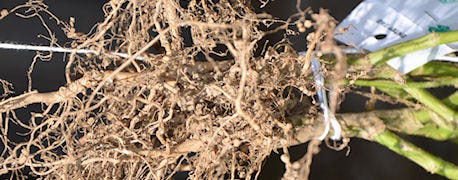
Have you ever checked out the whole soybean plants 4-Hers display for crops exhibits at the county fair? I not only check them out, I'm sometimes asked to judge the crops exhibits. One of the first things I look for is root mass on soybeans. And along with root mass, I want to see nodules. They contain the friendly bacteria that pull nitrogen out of the air and supply it for the plant.
In the stress year of 2012, nodules on some exhibit samples were few and far between. Last year nodules were plentiful again on soybeans not grown under stress.

Good nodules: These plants dug for a 4-H exhibit last year not only have good roots with lots of branching, there are lots of nodules present.
"We like to see at least six or more nodules on the main root, and maybe a total of six to 20 nodules per plant," says Brian Denning, an agronomist with Stewart Seeds based at Evansville. He assists with the AIM research program carried out for Stewart Seeds.
"The key thing other than number is to make sure the nodules are active and producing nitrogen," he says. "It's easy to tell. Slice them open. If they are a bright pink color they are doing their job. If they are gray or greenish then there may be a problem. Those particular nodules aren't fixing nitrogen from the air for the plant."
Related: Seed Treatment Can Protect Soybeans Early in the Season
Farmers have inoculated soybeans off and on since the 1930s. There are a variety of inoculants, and many products today have supposed super bacteria that are more able to help get the nodulation process started, Denning says.
Not everyone inoculates soybeans these days. Denning recommends that if you haven't grown soybeans in a field for three to five years, it will likely pay to inoculate the seed so that the rhizobia bacteria are plentiful enough to colonize roots and begin pulling in nitrogen.
This may be a factor on some farms this year that have been in continuous corn on some fields since corn prices jumped up several years ago, but who might be going back to soybeans in some of those fields this year.
About the Author(s)
You May Also Like




